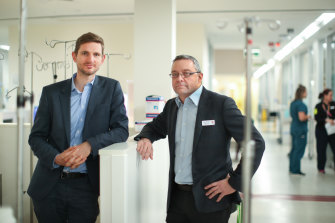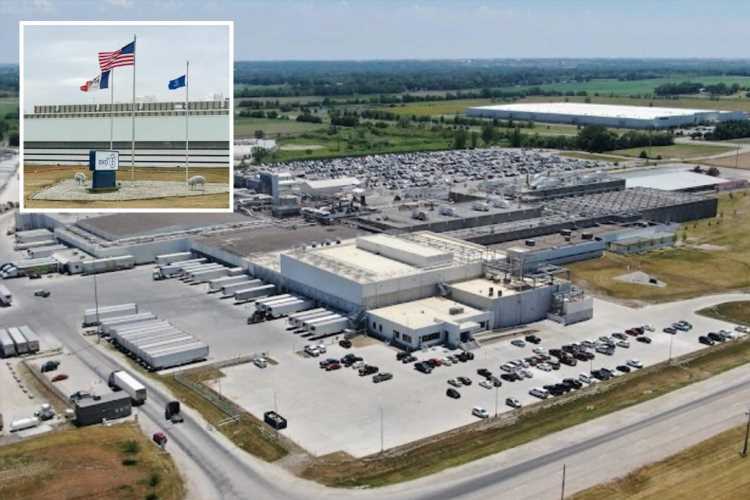For our free coronavirus pandemic coverage, learn more here.
The average age of Australians in ICU due to COVID-19 has plunged by more than a decade as the rolling Delta outbreak causes hundreds of younger people to fall very sick, including dozens of unvaccinated pregnant women.
Since the more infectious and deadly strain of the virus took hold in Sydney, before spreading to Melbourne and further afield, the median age of those admitted to intensive care with COVID-19 has fallen to 53 years.
It is a notable change from the first wave of infections in early 2020 when the median age was 64.
“We think that’s probably a reflection of Delta,” said Aidan Burrell, an intensive care doctor at The Alfred Hospital in Melbourne. “Delta is affecting the younger people who, in general, have fewer comorbidities.”
Dr Aidan Burrell with another intensive care doctor David Pilcher, who have been closely monitoring data on COVID-19 patients.Credit:Simon Schulter
Earlier this year, only one pregnant woman with COVID-19 had ever needed admission to an Australian intensive care unit. But in the few months since late June, another 48 women have been admitted to the wards dedicated to those needing life-saving treatment.
Only a handful were vaccinated, despite evidence pregnant women with COVID-19 are at greater risk of needing hospitalisation.
Melbourne obstetrician Nisha Khot said she’d seen data from some hospitals showing the rates of vaccination in pregnant women were “nowhere close” to the general population.
Dr Khot said misinformation was deterring some, but others were just generally anxious about introducing a foreign substance into their body while pregnant.
“I can understand that it’s a difficult decision you have to make,” she said, but she urged pregnant women to get vaccinated “for the simple reason they don’t want to be in ICU”.
In the ICU at Sunshine Hospital in Melbourne, there is a tiny resuscitation table for newborn babies responding to the increase in pregnant women needing critical care.
The intensive care data has been collated as part of an ongoing Australian study called SPRINT-SARI with COVID-19 data from 64 intensive care units.
It is broken down by three crucial phases – the first national wave of COVID-19 (from the start of the pandemic to July last year), the period encompassing Victoria’s second wave (until late June this year), and following June 25, after which NSW’s Delta outbreak took hold.
It revealed notable changes in admissions through Australia’s three main outbreaks, including a number of positive trends driven by better outcomes in the growing group of younger and healthier patients.
The median length of ICU stay has dropped from nine days to five between the first and third major COVID-19 waves.
But Dr Burrell, a chief investigator on the study with Monash University, said there was also a smaller subgroup of patients who were defying the trend, getting really sick, needing longer time on mechanical ventilation or experiencing multiple organ failure.
“We’re having younger deaths, which we never had in the first wave,” he said.
In the first wave, just 20.7 per cent of the 217 ICU admissions were those aged in their 40s or younger. That has risen to 40.1 per cent in the last outbreak, with at least 538 people in their 30s and 40s admitted to intensive care, 134 in their 20s, 37 aged 10 to 19 and a dozen younger children.
Dr Burrell said part of this trend was a result of older people having been largely vaccinated first in Australia, but he said Delta was also manifesting more severely in younger people than previous strains.
At The Alfred Hospital, they have more patients now using an advanced life support machine called ECMO than ever before.
Pre-pandemic the hospital might have admitted a couple of patients who needed the treatment due to the flu each year and there had been times when overall demand for the machine for pneumonia, heart problems and other conditions had been as high as 10 at any one time.
On Saturday, there were 17 patients at the hospital on ECMO, and medical lead of the COVID ICU at The Alfred, Julia Coull, said in the past two months patients have spent a similar number of hours on the machines than the entirety of their previous busiest year.
For those COVID-19 patients who needed the intervention, Dr Coull said their lungs were generally doing very little, with a pump used to instead oxygenate their blood.
“We would normally do what we call rest settings on the ventilator. We pretty much allow a small amount of oxygen to go in and out, but the ECMO machine will do the vast majority of the work.”
Despite Australia’s vaccination uptake now approaching world-leading levels, with more than 80 per cent of those over 16 now fully vaccinated, only 3.3 per cent of intensive care patients have been fully vaccinated – 68 out of 2037 patients recorded.
Many of those had only recently received a jab.
With Melissa Cunningham
Most Viewed in National
From our partners
Source: Read Full Article



